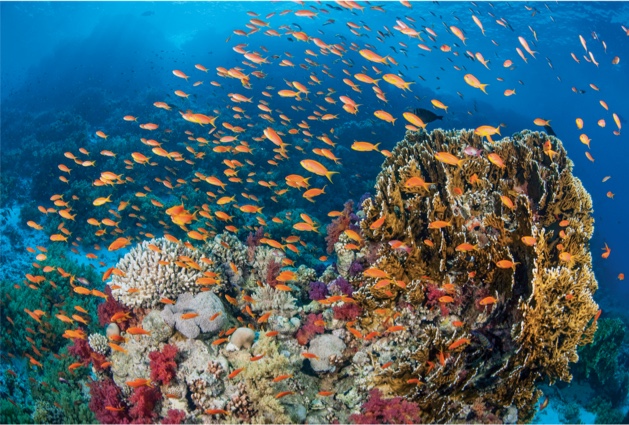It’smiddayoffthecoastofCancún,Mexico.You’reonaboatgettingreadyforareefdive.Youcheckyourgear.Thenyoutipbackwardofftheboatintotheclear,cool water.
Asyouswimdown,youseesomethingneartheseabed.Youdescendtonearly10meters(32feet).There,youcomeface-to-facewith… anotherface.Afacemadeofstone!Itispartofastatuecoveredinclumpsofalgaeand corals.
Thisisnottheonlystatueyousee.Therearemany.What’sgoingonhere?YoudoveintothemiddleofMUSA,a500-sculptureunderwatermuseum.Thisplaceisanartificialreef. ItwascreatedtoprotectsomeofMexico’snaturalreefs.Manyhavebeendamagedbystorms,boatanchors,and tourism.


Bigeyesliketheselivenearcoral reefs.
TheValueofReefs
Ouroceanscover71percentofEarth’ssurface.Theyhold97percentoftheplanet’swater.Werelyonouroceansfortheairwebreathe.Oceanplantsproducehalfoftheworld’soxygen.Oceanwatersabsorbalmostone-thirdofcarbondioxideemissions.TheoceansalsoregulatetheweatherandplayacrucialroleinEarth’swater cycle.
CoralreefsarethelargestlivingstructuresonEarth.Theyplayakeyroleinkeepingouroceanshealthy.Reefsalsoprotectshorelinesfromstormsandhightides.Reefsprovidefood,shelter,andprotection.Theyarespawningareasforfishandothermarineorganisms.Theyarestudyareasforscientists.Andmillionsofpeopleworldwidecountoncoralreefseverydayforfoodorincomefrom fishing.


ThisnaturalreefintheRedSeaisfullofmarine life.
ReefsinTrouble
Unfortunately,increasedhumanactivityisputtingastrainonthehealthofouroceansandreefs.Threatsincludefishingmethodsthatdamagereefs.Carelesstourism,pollution,andclimatechangethreatenthereefs, too.
HereinCancún,Mexico,morethan400,000touristsvisitedthenaturalreefseveryyear.Manyofthemwerebeginningdiverswhocausedmoredamagethanexperienced divers.
Thisreefwasdamagedbypeopleblastfishingwith dynamite.
Mexico’sNationalMarineParkcreatedtheunderwatermuseum,MUSA,todrawpeopleawayfromnaturalreefsandtowardartificialonesinstead.It’sworking.Fortypercentofthepeoplewhowouldhavevisitednaturalreefsnowvisit MUSA.
